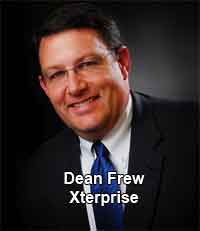 Frew added that he compares the RFID market to a rocket launch, with the initial Wal-Mart program being the first-stage booster that takes the spaceship so far, but then sputters out and returns to earth. Frew added that he compares the RFID market to a rocket launch, with the initial Wal-Mart program being the first-stage booster that takes the spaceship so far, but then sputters out and returns to earth.
“Now it’s time for the second and third boosters to add the power,” Frew said.
He also said there may be other drivers of RFID adoption than pure operational savings, such as the reduction of risk.
“One financial company said at a recent conference that if they lose a hard drive with customer data on it, they have to tell Congress in 10-12 days if they can’t find it in that time,” Frew said. “That’s a pretty powerful motivator to maintain control of those assets more effectively.”
On the role of “mandates” and compliance programs in driving RFID forward:
“Customers in the end probably have to drive much of this,” Frew believes. “Look at automotive, and all the benefits that have happened in that supply chain from the labeling the OEMs starting requiring all the way back in the early 1990s. Would the suppliers have ever done that on their own? Of course not. But in the end, it benefits the entire supply chain.”
“So I think it will largely fall on large companies to pull RFID through from their suppliers,” Frew said.
What is the prospect for some of these programs to start coming from additional retailers?
“In general, merchandise and grocery retail - that will be slow, gradual effort,” Frew said. “Fashion, shoes and apparel will be faster, and at the item level. A key issue will be complexities with source tagging in Asia, but as that gets resolved, it can really take off.”
In specialty retail, “You may see a lot of small rockets go off quickly,” Frew said.
On barriers to RFID adoption:
“Today, the hardware is very good, but it will help if prices continue to come down,” Frew said. He added that even now, if companies were to buy in volume, reader and tags could already be acquired at much greater discounts, “but you won’t have that with companies ordering onesy-twosies. You need larger volume purchases,” and that will only come as companies move beyond the pilot stage and small scale rollouts, he said.
He agreed that more information about RFID applications and their business benefits needs to be communicated to help spur adoption.
“Many companies have been doing detailed ROI analyses, but they have been keeping them private,” Frew said, and the big consultancies often want to keep their ROI insights to themselves as well.
Also, the potential benefits and application of RFID are “are often company-specific, and sometimes different even between sites within a company,” Frew said. “We’ve seen that many times – this plant has this application and ROI, and another, maybe which was acquired, has something different. Some are run by third parties, some in-house, etc. So the value equation varies,” he notes, and he adds that makes the insights into ROI at any one company less valuable to the general market.
But, Frew noted, in the fashion apparel market, “A general business case is emerging in terms of reduced out of stocks. If you can source tag and improve inventory management, there is this kind of return. You have maybe 15 companies saying that now.”
Frew said that using RFID, “You can do a rack inventory in 40 seconds versus something like 8 minutes with bar code, and that’s with a 30% error rate with bar code if you can get the 18-year-old worker to do it to begin with.”
In terms of barriers, Frew also says, “It comes back to the application problem again [see part 1 of this interview]. That is always the key to the discussion at the level we are usually at. Companies come to realize this could be transformational, and drive an incredible increase in asset utilization. But you need new applications to achieve those results.”
Some final thoughts:
“Sometimes, you just have to have a decent feel for the numbers, know this level of visibility can transform your business, decide “I’m jumping in,” and just make it happen,” Frew added.
“Then how long will it be before some competitor is sitting around a meeting and the CEO is saying, “Why is this competitor having stronger earnings than we are?” Someone will then say “They’re using RFID”, and the CEO will pointedly ask, “Why aren’t we doing that?” I think most businesses would rather be the first company, not the second one,” Frew concluded.
Do you agree with Frew’s perspectives on the RFID market? What would you add to his comments? Let us know your thought at the Feedback button below.
|